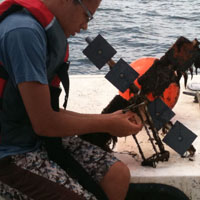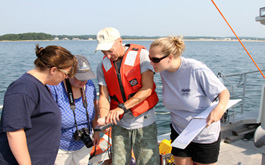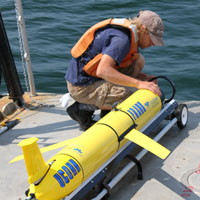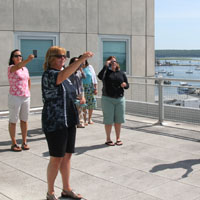Teacher Technology Experiences
COSEE-TEK sponsored three Teacher Technology Experiences (TTE’s) this summer, each was lead by researchers at the University of Connecticut’s Department of Marine Sciences and highlighted their research program and the technologies they use to study the ocean. The TTE’s also involved research technicians, graduate and undergraduate students as part of these Technology Team efforts. Each professional development TTE also featured an overview of ocean technologies, an opportunity for formal and informal educators to present the challenges of teaching and communicating ocean sciences to the scientists, data collection and analysis, and drafting of technology based educational resources. Pre-post concept maps and a teacher ocean technology content survey were conducted to assess teacher ocean technology content knowledge and scientists awareness of the challenges of implementing formal and informal ocean science broader impacts.
"Glide with the Tide"
Dr. Jim O’Donnell, a physical oceanographer, lead the first COSEE-TEK Teacher Technology Experience (TTE) that focused on several technologies used to sample the dynamic physical oceanography of the near shore environment of Long Island Sound (LIS). The technologies used included a conductivity, temperature and depth (CTD) sampler, an acoustic doppler current profiler (ADCP) and an autonomous underwater glider to collect a range of data in Long Island Sound. This combination of technologies provided point (CTD), transect (glider) and time series (ADCP) data to assess the physical characteristics of coastal LIS. In addition, the Long Island Sound Integrated Coastal Observing System (LISICOS) web-based data was used as a longitudinal data set providing a longer time series of observations of several physical oceanographic parameters at several buoy locations along Long Island Sound.
“Hiding in the Light”
Dr. Heidi Dierrsen a biological oceanographer lead COSEE-TEK’s second Teacher Technology Experience (TTE) focused on a variety of technologies used to understand the optical properties of light in the ocean. Images acquired with a hyperspectral imager were compared to images obtained using conventional digital cameras. Freely downloadable image analysis software (ImageJ) was utilized to analyze images taken of different species of fish at the Mystic Aquarium to assess the effectiveness of different camouflage strategies. Lab experiments included measuring light transmission at various wavelengths and water clarity and using polarizing filters to assess fish scales ability to polarize light.
“The Courtship of EVA and BOB”
 Dr. Penny Vlahos and Dr. John Hamilton lead this TTE that featured teachers building a Basic Ocean Buoy (BOB) that they used to deploy Dr. Vlahos’ passive water quality sensors she has developed that use ethylene vinyl acetate (EVA) embedded with markers to sample for a number of existing pesticides and emerging (flame retardants) contaminants. The BOB also was designed to accommodate biological settling plates identical to those that have been deployed by Dr. Hamilton in Long Island Sound for a decade to assess short (2 week) and longer (months) settlement patterns and dynamics. The samplers and plates were initially be deployed on pilot BOBs that COSEE-TEK designed based upon the original BOB developed by NOAA and COSEE-Southeast. Teachers also were involved with preparation of the EVA samplers and provided an overview of the lab analysis of the EVA samplers. In addition, they also assisted with the recovery of the pilot BOBs and received an overview of how to census the settling plates for percent cover of the dominant organisms. Teachers wre also provided with a Hobo temperature monitor to be deployed on their BOB to provide a long term record of ocean surface temperature.
In Fall 2011, all participants of the TTE program (scientists, staff, students and teachers) participated in a Teacher Ocean Technology Institute (TOTI) that reviewed the scientific findings for each project and presented the lesson plans and resources that were developed. Other interested teachers are encouraged to follow the activities on our website, explore resources developed, and contact us for future opportunities with COSEE-TEK.
|











